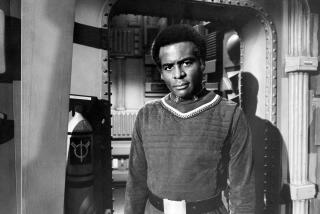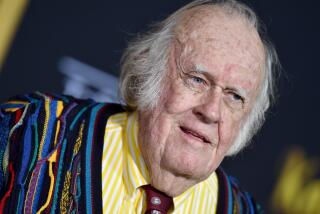Richard Erdman, prolific actor who appeared in ‘Stalag 17’ and ‘Community,’ dies at 93
Richard Erdman, a wisecracking character actor who appeared in more than 175 film and television productions, including as a barracks chief in “Stalag 17,” a time-stopping boor in “The Twilight Zone” and an elderly college student on the more recent sitcom “Community,” has died at an assisted-living facility in Los Angeles. He was 93.
He had dementia and suffered a fall about two weeks ago, said film historian Alan K. Rode, an executor of his estate. He died Saturday .
For many viewers, Erdman was the consummate “that guy” — a difficult-to-identify-but-recognizable supporting player who injected wit and energy into television shows such as “Perry Mason,” “Cheers,” “Murder, She Wrote” and eventually “Community,” which endeared him to a younger generation when the series premiered on NBC in 2009. It moved to Yahoo’s streaming service for its sixth and final season in 2015.
Erdman made his film debut as a messenger boy in “Mr. Skeffington” (1944), starring Bette Davis, and went on to appear in dozens of crime dramas and military epics, often as the hero’s witty sidekick.
He performed in radio programs with Orson Welles and Jack Benny; was featured in films alongside James Cagney (“The Time of Your Life”), Errol Flynn (“Objective, Burma!”) and Dorothy Lamour (“Wild Harvest”); and played a paraplegic soldier in Marlon Brando’s first movie, “The Men” (1950).
The two actors spent several days at a veterans hospital near Los Angeles to learn how to use a wheelchair, and Brando lived at Erdman’s Hollywood Boulevard apartment for four weeks during the film shoot, passing the time listening to his host’s sprawling collection of Russian opera records.
Erdman drew early acclaim for his performance in “Cry Danger,” a 1951 film noir starring Dick Powell and Rhonda Fleming, in which he played an alcoholic Marine veteran with an artificial leg. In a 2012 interview with Rode, Erdman recalled auditioning in front of the movie’s screenwriter, William Bowers, who told him, “When you read the script, don’t make faces, and stop acting. Just say the words.”
Following that advice, he offered a deadpan response when his character was shot in the wooden leg. Asked what sort of prosthesis he’d like as a replacement, Erdman replied: “I’d like it in knotty pine, to match my den.”
Erdman never quite found the right part, although he came close with “Stalag 17” (1953), director Billy Wilder’s World War II classic about a German prisoner of war camp. Adapted from a Broadway play by Donald Bevan and Edmund Trzcinski, the film featured William Holden as a gruff American prisoner, with Erdman cast against type as the no-nonsense chief of the barracks.
Erdman later appeared on TV programs such as “The Tab Hunter Show” (1960-61) as a wealthy playboy, and “The Twilight Zone,” which featured him in a celebrated 1963 episode, “A Kind of a Stopwatch,” as a barfly who receives a watch that enables him to pause time.
In “Community,” he played Leonard Rodriguez, a sardonic member of the “Hipsters,” a clique of Greendale Community College students who’ve all had hip replacements, or are old enough to have done so.
The character became known for annoying his younger community college classmates, especially Jeff Winger (Joel McHale). Erdman was always met with the words, “Shut up, Leonard,” followed by one of a dozen or so insults: “I heard about your prescription socks,” or “Those teenage girls you played ping-pong with are doing it ironically.”
Occasionally, the show would also nod toward Erdman’s storied acting career. “I’m thinking about breaking into the TV game, since it’s apparently sticking around,” he says in one episode. “I don’t want to wake up in 30 years and wonder, ‘What if?’”
John Richard Erdman was born in Enid, Okla., on June 1, 1925, and was raised in Colorado Springs, Colo. His father abandoned the family when Erdman was a boy, according to Rode, and his mother ran a bakery.
According to a 1972 profile in the Colorado Springs Gazette Telegraph, Erdman and his mother moved to Los Angeles when he was a junior in high school, after his drama teacher suggested he could act in movies. Soon after graduating from Hollywood High School, he signed a seven-year contract with Warner Bros.
But he battled with studio executive Jack Warner, who refused to loan him out for producer Samuel Goldwyn’s 1946 war film “The Best Years of Our Lives.” Erdman said he was offered the part of a disabled veteran who had lost both hands, but the role ultimately went to Harold Russell, who received honorary and best supporting actor Oscars.
Erdman’s other movie appearances included “You’re in the Navy Now” (1951), starring Gary Cooper and Jane Greer; “The Blue Gardenia” (1953), a film noir directed by Fritz Lang; and “Tora! Tora! Tora!” (1970), about the attack on Pearl Harbor. He also directed “The Brothers O’Toole” (1973), a Western comedy, and in the 1950s and ’60s was a leader of Stage Society, a Los Angeles theater troupe.
His marriage to Leza Holland ended in divorce. He married Sharon Randall in 1953, and she died in 2016. Their daughter, Erica Erdman, died in 2010. Erdman left no immediate survivors.
While Erdman was far from a household name, he said he was often approached at parties or met with a look of vague recognition. “It’s the face,” he told the Salt Lake Tribune in 1967, while leading a summer theater program at the University of Utah. “I look like the fellow you should know, but can’t remember his name.”
“In only about two of the pictures did I ever get the girl,” he added. “Usually I play the leading lady’s boyfriend who is left at the altar while the heroine elopes with Cary Grant. That’s why I like to act in Utah. In Utah, I get the girl. In Hollywood and on Broadway, I end up in second place.”
Smith writes for the Washington Post.
More to Read
Start your day right
Sign up for Essential California for the L.A. Times biggest news, features and recommendations in your inbox six days a week.
You may occasionally receive promotional content from the Los Angeles Times.






